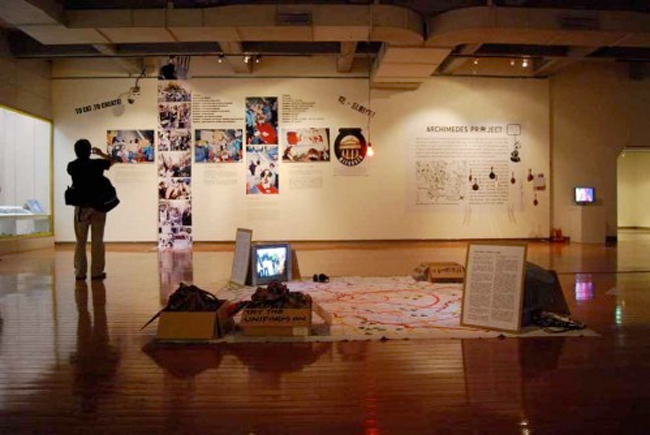
Exposition Météo des forêts
Entre constat des impacts de la crise climatique en cours et possibilité de résilience, l’exposition Météo des forêts propose des…

An exhibition on the counter-globalization movement
Foreman Art Gallery of Bishop’s University
Sherbrooke, Canada
January 27 to March 20, 2010
http://www.ubishops.ca/foreman/english/exhibitions/2009-2010/worlds/index.html
Artists: ATSA (Canada), Zanny Begg (Australia), Etcétera (Argentina), Petra Gerschner (Germany), John Jordan (England), Oliver Ressler (Austria), ®TMark (United States), Gregory Sholette (United States), Nuria Vila + Marcelo Expósito (Spain), Dmitry Vilensky (Russia)
Curated by Oliver Ressler
The trope “A World Where Many Worlds Fit” goes back to the Subcomandante Marcos, when talking about the Zapatistas’ struggles in the Lacandonian Rainforest in Mexico. Since their uprising in 1994 the Zapatistas have been fighting for a less-hierarchic autonomous world where more options exist for involvement in democratic decision-making processes. They fight against an existing world, which calls itself “democratic”, but should rather be seen as a form of sophisticated oligarchy that functions in favor of the interests of the political and economic elite. While the Mexican army and paramilitary mercenaries are brutally defending this exclusive world of the elite in Chiapas, in the part of the world where I am coming from (Austria/Europe) the stick that punishes people who envision another world is usually not so visible. But this can change suddenly in times when those in power assemble in the framework of the summits of World Bank, International Monetary Fund, World Trade Organization, World Economic Forum or the G8. Though the decisions made by the politicians and business leaders at these meetings affect the lives of all people in the world, the negotiations take place hidden from the public gaze behind fences and ten-thousands of riot-police, becoming, therefore, a symbol for the undemocratic and illegitimate formation of global capitalism.
At each of these summits individual and collective singularities from all over the world come together to express that they – we – are opposed to this way of making decisions and ruling the world. These mobilizations against the summits form the movements’ most visible public appearance, movements that according to most narratives, originated at the 1999 protest against the World Trade Organization in Seattle. These articulated forms of resistance and protest in the center of capitalism, were strong enough to shut down the WTO summit in Seattle. Since 1999 this global movement has been showing up at each meeting of World Bank, IMF, WTO, WEF – unless, that is, the scared politicians decided to meet in the mountains, in deserts or in dictatorships in order to avoid the public manifestations of dissent at their summits. Even though this movement is the first that is truly globalized, it is usually being called counter-globalization movement. I prefer calling it the “movement of the movements”.
At the demonstrations, counter-summits and mass blockades many individuals and collectives come together: media activists, clown army, pink block, naked block, black block, anarchists, socialists, Trotskyists, members of ATTAC, human rights activists, feminists, migrants, indigenous people, artists, etc. All these singularities have their own images, banners, different public appearance and slogans, which not only represent something, but contribute to the creation of effective blockades and to the creation of a space. This space of representation is also a space for action that in the best cases spreads to other areas such as the local neighborhoods of the activists. This new social subject, sometimes referred to as “the multitude”, builds horizontally organized networks and has a radial transformation of society in mind.
The exhibition “A World Where Many Worlds Fit” at the Foreman Art Gallery of Bishop’s University in Sherbrooke is based on a section I curated for the Taipei Biennial in 2008 that presents the global movement as the brilliant example of collective intelligence it is through a variety of artistic practices. The exhibition features the work of 10 artists that focus directly on the counter-globalization movement. All artists show a strong commitment to the social movement and do not position themselves as “neutral” in relation to the movement. Many of the works focus on one of the cities whose name has become shorthand for demonstrations, counter-summits and/or blockades: Seattle, Prague, Québec City, Genoa, Buenos Aires, Gleneagles, St. Petersburg or Heiligendamm.
For further information on the participating artists and images from the pervious exhibition at the Taipei Biennial 2008 please check http://www.ressler.at/a_world_where_many_worlds_fit/
Entre constat des impacts de la crise climatique en cours et possibilité de résilience, l’exposition Météo des forêts propose des…
Une exposition qui explore les liens entre Deep Listening et écologie, dans le nouvel espace de la Fondation Pernod Ricard,…
Exposition sur le lien environnemental entre la rivière et le castor à l'Artothèque, Espaces d'art contemporain, Caen

